
Bechyně Castle
This originally princely settlement in Bechyně, mentioned as early as the 9th century, is situated on the southernmost rock promontory above the confl uence of the Lužnice River and Smutná stream. Before 1268, King Přemysl Otakar II obtained the…
Go to detail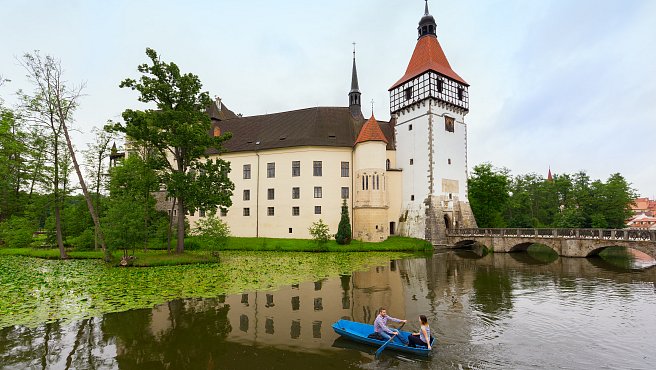
Blatná Water Castle
The first written mention of the former castle comes from 1235. A wooden fortress had been erected on a rocky island in the middle of a swamp and later rebuilt into a castle. The most famous period of the castle’s history is related to the Lev…
Go to detail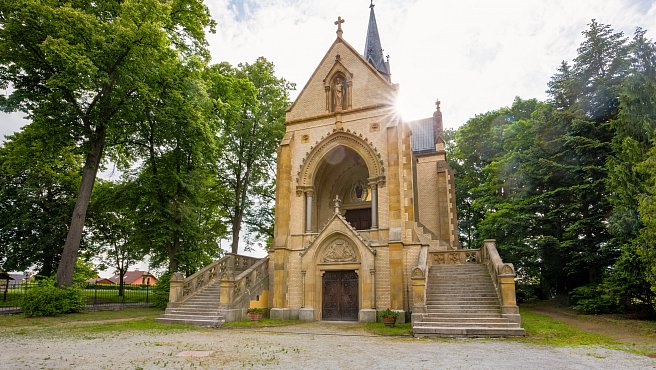
Bucquoy Tomb in Nové Hrady
The Bucquoy tomb is a significant dominant feature of the Nové Hrady cemetery. It was built based on the project of Joseph Schulz in 1902-1904 as a Neo-Gothic chapel and has two parts: a crypt in the basement and a chapel on the upper fl oor. The…
Go to detail
Bušek Hammer Mill
The Bušek Hammer Mill is a functioning technical monument, one of three of its kinds in the Czech Republic. It originated in 1780 through the reconstruction of the original mill. The hammer is driven by three waterwheels launching into operation a…
Go to detail
Castle and chateau of Český Krumlov – UNESCO
The monumental complex of the castle and chateau of Český Krumlov is extraordinary in its architecture, cultural tradition, and size, and has rightfully been inscribed on the UNESCO List. The castle premises, built by the Vítkovec family and rebuilt…
Go to detailČervená Lhota State Castle
The castle, standing on a rocky island above the surface of a pond, hides in its core the remnants of an original fortress from the 14th century. The current Renaissance building was built after 1530 but was further developed in the course of the…
Go to detail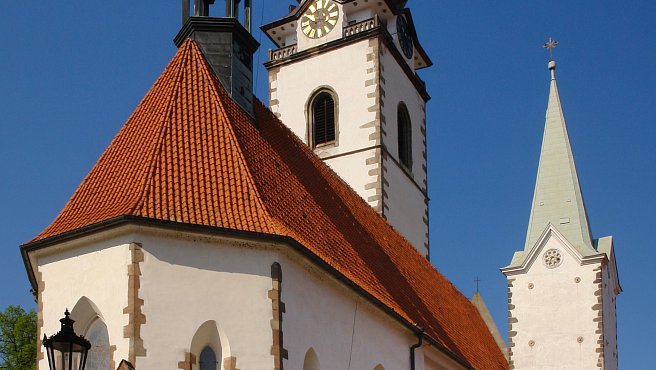
Church of Birth of Virgin Mary in Písek
The parish church in Písek is one of the best-preserved architectonic monuments of the early Gothic style in Bohemia. It is one of the works of the great stone-mason works in Písek and Zvíkov which also participated in many other building activities…
Go to detail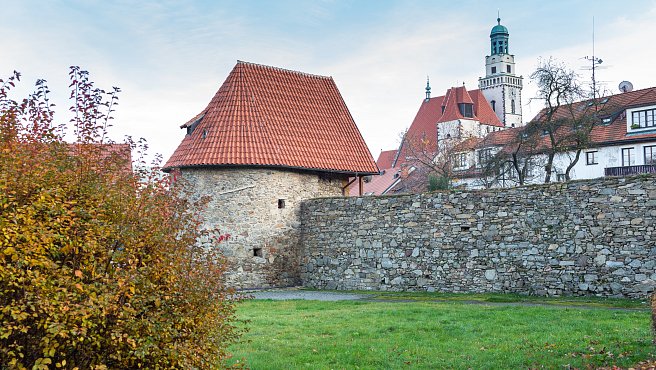
Church of St. James the Greater in Prachatice
The church was founded as early as the 14th century and gained its current appearance upon its reconstruction at the beginning of the 16th century, when it was enlarged to three naves, obtained new vaulting and a new roof, but only the 53-meter…
Go to detail
Church of Virgin Mary the Queen and St. Giles and Augustinia
The dean church has been recorded as a parish since 1280. After the foundation of the Augustinian monastery in 1367, the church was rebuilt in the Gothic style. At that time, probably the most signifi cant painter of Gothic panel paintings in…
Go to detailCistercian Monastery in Vyšší Brod
The Cistercian abbey of Our Beloved Lady in Vyšší Brod is currently the only living male monastery of the Cistercian Order in Bohemia. This is one of the most signifi cant cultural monuments in Southern Bohemia. This renowned Šumava monastery was…
Go to detail
Dačice State Castle
The original Renaissance castle was built at the end of the 16th century for the family of Krajířů of Krajk and it gained its current appearance over the course of its reconstruction in the 1930s. A guided tour around the castle off ers 21 rooms…
Go to detailDominican Monastery in České Budějovice
The Dominican Monastery with its Temple of Sacrifi ce of the Virgin Mary is the oldest monument in České Budějovice. It was founded together with the town in 1265 and became a part of the town walls. In the convent we can fi nd a Paradise Yard…
Go to detail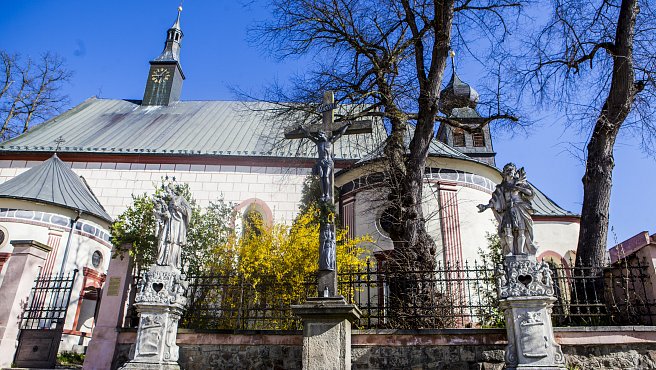
Franciscan Monastery with Church of St. Catherine in Jindřic
The Franciscan Monastery with Church of St. Catherine was built in 1478 and consecrated in 1491. In 1619, during the uprising of the Estates, the church with the convent was destroyed by fi re. Consecration of the repaired church was performed in…
Go to detailHelfenburk Castle
These ruins of a Gothic castle, founded in the 14th century by the Rožmberk family, are located near Bavorov on a forested hill named Malošín. In the 15th and 16th century, the castle was gradually reconstructed. An 18-meter circular Great Tower…
Go to detail
Historical Railway from Tábor to Bechyně
The railway from Tábor to Bechyně was the first electrified railway track on the territory of former Austria-Hungary. The plan of the railway connection from Tábor to Bechyně comes from the end of the 19th century. In the same period, František…
Go to detail
Hluboká nad Vltavou State Castle
This romantic building was erected on the site of a Baroque castle with an extensive sub-castle area in 1839-1871, inspired by English Tudor and Elizabethan architecture. The princely couple of Johann Adolf II of Schwarzenberg with his wife Eleonora…
Go to detailHolašovice – UNESCO
Holašovice is the best-preserved example of South Bohemian architecture from the second half of the 19th century. This is a unique set of farm buildings, built and decorated to produce a specific look known as Rustic Baroque, centered around a large…
Go to detail
Horse-Drawn Railway from České Budějovice to Linz
The main reason for the construction of the horse-drawn railway from České Budějovice to Linz was to transport salt from the Austrian Salt Chamber to Bohemia. The construction was initiated under the management of engineer František Antonín Gerstner…
Go to detailHoslovice Water Mill
This unique preserved water mill for upper water is over 400 years old. The unique mill, with its repaired historical equipment, is a suitable place for traditional craft production. Many events illustrating life in a village, including maintained…
Go to detail
Jewish Synagogue in Český Krumlov
The Synagogue, or Temple, was built in 1909. This was the first building in Austria-Hungary for the construction of which a reinforced concrete structure was used. The architect Viktor Kafka designed the temple as a simple one-nave building with a…
Go to detailJindřichův Hradec Castle and Chateau
The castle and chateau in Jindřichův Hradec is one of our most beautiful and monumental castle premises. Under the reign of the last Lords of Hradec, Jáchym and Adam II, the originally Gothic castle was magnifi cently reconstructed into a…
Go to detail
Kratochvíle State Castle
This is one of our most beautiful Renaissance buildings, situated in the picturesque countryside amidst middle of forests, pastures, and ponds, and was built in 1583-1590 by Vilém of Rožmberk. This unique Renaissance and Mannerism building was…
Go to detail
Landštejn Castle
One of the most signifi cant Roman monuments in Central Europe, this was built as a base for the Moravian Přemyslid family to protect the provincial routes in the Vitorazs Region at the beginning of the 12th century. The domain was soon obtained by…
Go to detail
Lipno Dam
This is a water work built on the Vltava River in 1952-1959. With its area of 48.7 km2 this is the largest dam reservoir and the largest water area in the Czech Republic, thanks to which it is also frequently known as the Czech or South Bohemian Sea…
Go to detail
Lnáře Castle
In 1670-1686, a two-storey four-wing castle was built next to the Medieval fortress. The castle construction was initiated by the Earl of Mitrovice Aleš Vratislav, and was completed by Tomáš Zacheus, the son of Earl Humprecht Jan Černín of Chudenice…
Go to detail
Memorable Cemetery in Albrechtice nad Vltavou
This originally Romanesque Church of St. Peter and Paul comes from the 12th century and is one of the most signifi cant churches in Southern Bohemia also thanks to its interior paintings, where the walls are covered with a monumental composition of…
Go to detail
Minorite monastery and Monastery of the Poor Clares with Chu
The former Minorite monastery with the Church of Corpus Christ in Český Krumlov is a unique historic complex comprising three monasteries in total: Minorite, St. Clare and Beguine. The monasteries were founded approximately in the middle of the 14th…
Go to detail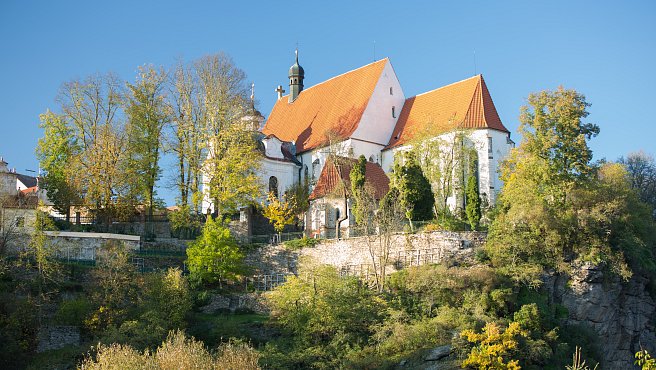
Minorite Monastery in Bechyně
The Minorite Monastery in Bechyně, with its Church of Assumption of the Virgin Mary located in the town center, is situated on a rock promontory on the right bank of the Lužnice River. It was founded in the second half of the 13th century but was…
Go to detail
Mitrowicz Castle
A romantic castle located on the bank of the Lužnice River near Týn nad Vltavou. The original fortress from 1565 was rebuilt in 1737-1741 under the direction of Earl František Wratislav of Mitrowicz. The residential part was extended with the chapel…
Go to detailMonastery in Borovany near České Budějovice
This Augustinian monastery was founded in 1455 by Petr of Linda. Its rather small paradise garden is surrounded by a late Gothic cloister with a mesh vault. Aft er its reconstruction in 1729, the tower on the northern part of the church became a…
Go to detailMonastery of Divine Mercy in Nové Hrady
The Monastery of Divine Mercy in Nové Hrady was built in the vicinity of the church of St. Peter and Paul on the initiative of the local noble the Bucquoy Family. In 1677, Earl Ferdinand Bucquoy invited monks from the Servite Order to Nové Hrady,…
Go to detail
Municipal Power Plant in Písek
The municipal power plant in Písek is the oldest functioning water power plant in Bohemia. It was founded aft er a successful demonstration of lighting in the town by František Křižík on 23 June 1887. Písek thus became the fi rst town in Bohemia…
Go to detail
Narrow-gauge Railways in the Jindřichův Hradec Region
The starting point of this narrow-gauge railway is the city of Jindřichův Hradec, where 2 tracks start: to the north in the direction of Obrataň and to the south in the direction of Nová Bystřice. The operation of this track was initiated in 1897.…
Go to detailNové Hrady State Castle
This passage-way castle, with its two opposite gates and deep moat, was founded by the Vitkovec Family in the second half of the 13th century. The town walls were adjacent to the castle wall and protected the inhabitants of the surrounding town.…
Go to detail
Old Tábor Town Hall
The Old Town Hall in Tábor is one of the most signifi cant late Gothic monuments in Czech towns. This national cultural monument, with its unmistakable square Pseudo-Gothic tower, is one of the dominant features of the city of Tábor. The Town Hall…
Go to detail
Orlík Castle
The castle gained its name (orlík = young eagle) due to its location high on a rock and above the valley of the Vltava River and is attractive even today thanks to its unique location in the countryside on the bank of the Orlík Reservoir. The castle…
Go to detailOrlík Reservoir
This water work shows several rarities. First, this lake has the greatest amount of water in Bohemia, has the highest concrete dam, and the second most powerful water plant in the Czech Republic. The dam itself is gravitational and the concrete from…
Go to detail
Pilgrimage Church of the Assumption of the Virgin Mary in Kl
At the edge of Tábor, on a hill above the curve of the Lužnice River stands the impressive building of the pilgrimage church in Klokoty. The present Baroque pilgrimage premises with the Church of Assumption of Virgin Mary was founded around 1700 and…
Go to detailPilgrimage Church of the Virgin Mary and Marian Pilgrimage S
Lomec is one of the most famous pilgrimage sites in Southern Bohemia. The Pilgrimage Church of Virgin Mary is one of signifi cant works of the high Baroque in Central Europe. The church was built in1692 - 1702 by Earl Bucquoy for the miraculous…
Go to detail
Premonstratensian Monastery in Milevsko
The monastery in Milevsko is the oldest monastery in Southern Bohemia and was founded in 1184 by the magnate Jiří of Milevsko. Its original Romanesque style from the end of the 12th century has been mostly preserved until today. In the second half…
Go to detailRožmberk State Castle
Rafters and boaters oft en think that they are seeing two different castles stretch above the water in the meanders of the Vltava River. The older Lower Castle, built in the fi rst half of the 13th century by the Vítkovec Family, was joined at the…
Go to detail
Schwarzenberg timber floating canal
The Schwarzenberg timber fl oating canal connects Světlá, which is one of the tributaries of the Studená Vltava River, and the Austrian river Große Mühl, a tributary of the Danube River, thus connecting the drainage basin of the Nothern Sea and the…
Go to detailSchwarzenberg Tomb in Třeboň
The tomb is located 1.5 km from the center of Třeboň on the southern part of the lake Svět. The construction was initiated in 1784. The two-storey building, shaped like a regular octagon, is built in Pseudo-Gothic style according to the Italian…
Go to detail
Stádlec Bridge
This bridge over the Lužnice River was built in 1975 below the town of Stádlec and is the last preserved Empirical chain bridge in the Czech Republic. Originally, in 1848 -1960, it spanned the Vltava River near Podolsko. In 1959 it was declared a…
Go to detailStone Bridge in Písek
The town of Písek prides itself with the oldest surviving stone bridge in Bohemia. It was built by the royal stone-mason works in Písek and Zvíkov before the end of the 13th century. It has seven arches, a length of 110 meters, and a width of 6.5…
Go to detailStožec Chapel in Stožec
The Chapel of Virgin Mary, also known as the Stožec Chapel, is an example of folk wood carving. The original wooden chapel was built in 1791 by the blacksmith J. Klauser, who was grateful to the water from this spring for curing his sight. In 1804…
Go to detail
Strakonice Castle
This castle was founded at the confl uence of the Volyňka and Otava Rivers in 1220-1235 by the noble family of Bavor. In 1243, Bavor I gave the eastern part of the castle to the Order of Saint John who established commandries there. The Order of…
Go to detailStud Farm in Písek
The stud farm in Písek is a complex of unique buildings made of brickwork. Since 2010, it has been a national cultural heritage monument and is visible from the main road on the route from Prague to České Budějovice when using the ring road around…
Go to detail
The Church of St. Procopius in Strakonice
The deanery Church of St. Procopius is one of the most signifi cant monuments in Strakonice. It is located in the premises of the Strakonice Castle at the confl uence of the Volyňka and Otava Rivers. It was founded by the noble family of Bavor from…
Go to detail
Třeboň pond system
In the originally swampy countryside of the Třeboň Region, the establishment of lakes associated with fi sh breeding became a profitable economic activity. At the turn of the 15th and 16th centuries, Petr IV of Rožmberk became the owner of the…
Go to detail
Třeboň State Castle
This originally small, town castle served the Rožmberk Family from 1366 for occasional stays in the Třeboň dominion. After a fire in the town in 1562, the destroyed castle was gradually reconstructed into a Renaissance chateau as ordered by Vilém of…
Go to detail
Vimperk Castle
The original Vimperk castle was founded around the half of the 13th century as a guard fortress above the Golden Path leading from Bavaria to Bohemia. The castle passed through the hands of many noble families – Janovic, Kaplíř of Sulevice, Malovec…
Go to detailŽdákov Bridge
The bridge construction was initiated simultaneously with the construction of the Orlík Reservoir in 1957. The construction cost 71 million Czechoslovak crowns and it was defi nitively completed in 1967. At that time, the bridge was considered the…
Go to detail
Zlatá Koruna Monastery
The premises of this former Cisterican monastery founded by King Přemysl Otakar II on a rocky promontory in the deep Vltava valley in 1263 is one of the best preserved Gothic monasteries in Bohemia. The unique Chapel of Guardian Angels, the chapter…
Go to detail
Zvíkov Castle
The originally royal castle stretching above the surface of the Orlík Reservoir is oft en called the “king of Czech castles” and it rightfully has its place among the gems of the Czech early Gothic architecture. The first written mention comes from…
Go to detail